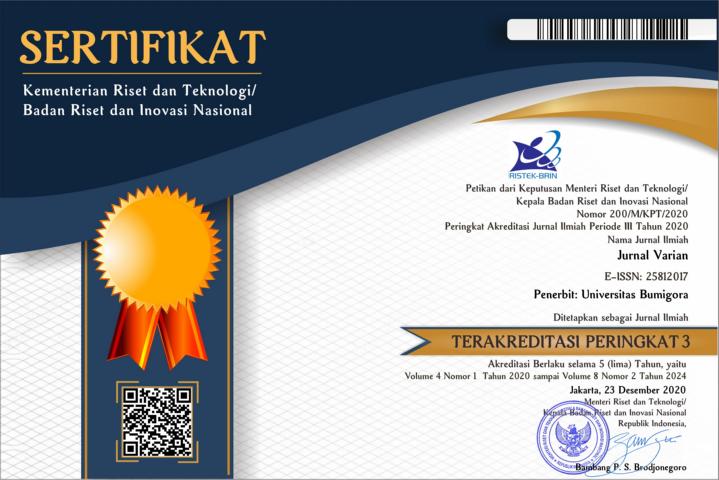Modeling the Number of High School Dropouts Using GWGPR
DOI:
https://doi.org/10.30812/varian.v8i1.4248Keywords:
Dropout, GWGPR, Overdispersion, Senior High SchoolAbstract
In 2022, the high school dropout rate is the highest compared to other levels of education in Indonesia.
Seeing the urgency of the 12-year Compulsory Education program, completing education up to the high
school level is an important thing that needs to be considered. Thus, it is necessary to know the factors
that influence the dropout rate in the hope that this problem can be reduced. This study aims to model
the high school dropout rate using geographically weighted generalized poisson regression (GWGPR)
based on the factors that influence it. GWGPR is used if the response variable is overdispersed and
depends on the location observed. The results of this study indicate that each province has a different regression model. The GWGPR model with the adaptive tricube kernel weighting function is the
best model because it has the smallest AIC value compared to other weighting functions. In Central
Sulawesi Province, the GWGPR model with the adaptive tricube kernel weighting function formed is
µˆ26 = exp (8, 1267 − 0, 1267X4 + 0, 0344X5 + 0, 0957X6 + 0, 1173X7). With the significant variables are the average length of schooling, the percentage of the population aged 7-17 years who receive
PIP, the open unemployment rate, and the percentage of children who do not live with parents.
References
Menentukan Faktor-faktor Yang Mempengaruhi Indeks Pembangunan Manusia di Provinsi Sulawesi Selatan. Jurnal Ilmiah
Sains, 23(2), 140–148. https://doi.org/10.35799/jis.v23i2.48867
Al-Hasani, G., Asaduzzaman, M., & Soliman, A.-H. (2021). Geographically weighted Poisson regression models with different
kernels: Application to road traffic accident data. Communications in Statistics: Case Studies, Data Analysis and
Applications, 7(2), 166–181. https://doi.org/10.1080/23737484.2020.1869628
BPS. (2022). Statistik Pendidikan 2022. Badan Pusat Statistika.
Hakim, A. (2020). Faktor Penyebab Anak Putus Sekolah. Jurnal Pendidikan, 21(2), 122–132. https://doi.org/10.33830/jp.v21i2.
907.2020
Hong, Z., Mei, C., Wang, H., & Du, W. (2021). Spatiotemporal effects of climate factors on childhood hand, foot, and mouth
disease: A case study using mixed geographically and temporally weighted regression models. International Journal of
Geographical Information Science, 35(8), 1611–1633. https://doi.org/10.1080/13658816.2021.1882681
Leonita, L., Jeby, N. H., Sevien, & Ohyver, M. (2023). Predicting Cancer Death Rate and Determining the Major Cause of Cancer
using Ridge Regression. Procedia Computer Science, 227, 599–605. https://doi.org/10.1016/j.procs.2023.10.563
Limbong, F. S., & Setiadi, Y. (2021). Faktor-Faktor yang Mempengaruhi Putus Sekolah Jenjang SMA/Sederajat di Provinsi DKI
Jakarta Tahun 2019. Prosiding Seminar Pendidikan Matematika dan Matematika, 3, 1–8. https://doi.org/10.21831/
pspmm.v3i0.144
Lumbantoruan, J. F. A. K., Ohyver, M., & Moniaga, J. V. (2023). Developing a Poverty Model in Papua using Geographically
Weighted Regression. Procedia Computer Science, 227, 243–252. https://doi.org/10.1016/j.procs.2023.10.522
Mahama, A., Awuni, J. A., Mabe, F. N., & Azumah, S. B. (2020). Modelling adoption intensity of improved soybean production
technologies in Ghana - a Generalized Poisson approach. Heliyon, 6(3), e03543. https://doi.org/10.1016/j.heliyon.2020.
e03543
Nisa, R. F., Sugito, S., & Hakim, A. R. (2022). Pemodelan Mixed Geographically Weighted Regression dengan Adaptive Bandwidth
untuk Angka Harapan Hidup (Studi Kasus : Angka Harapan Hidup di Jawa Tengah). Jurnal Gaussian, 11(1), 67–76.
https://doi.org/10.14710/j.gauss.v11i1.33998
Purhadi, Sari, D. N., Aini, Q., & Irhamah. (2021). Geographically weighted bivariate zero inflated generalized Poisson regression
model and its application. Heliyon, 7(7), e07491. https://doi.org/10.1016/j.heliyon.2021.e07491
Sabtika, W., Prahutama, A., & Yasin, H. (2021). Pemodelan Geographically Weighted Generalized Poisson Regression (GWPR) Pada
Kasus Kematian Ibu Nifas di Jawa Tengah. Jurnal Gaussian, 10(2), 259–268. https://doi.org/10.14710/j.gauss.10.2.259-
268
Safire, E. D., & Purhadi. (2023). Pemodelan Faktor-Faktor yang Mempengaruhi Jumlah Kasus Diabetes Melitus di Jawa Timur
Menggunakan GWGPR dan GWNBR. Inferensi, 6(1), 1–14.
Sari, R. N., Nabilla, U., & Sari, R. P. (2023). Poisson Regression Modeling Generalized in Maternal Mortality Cases in Aceh Tamiang Regency. BAREKENG: Jurnal Ilmu Matematika dan Terapan, 17(1), 0235–0244. https : / / doi . org / 10 . 30598 /
barekengvol17iss1pp0235-0244
Septianto, T., Pramadhana, D., & Haromainy, M. M. A. (2023, August 26). Matematika Komputasi untuk Vokasi. Thalibul Ilmi
Publishing & Education.
Tyas, S. W., Gunardi, & Puspitasari, L. A. (2023). Geographically weighted generalized poisson regression model with the best
kernel function in the case of the number of postpartum maternal mortality in east java. MethodsX, 10, 102002. https:
//doi.org/10.1016/j.mex.2023.102002
Widyaningsih, Y., & Budiawan, Z. A. (2023). Poisson Regression Models to Analyze Factors That Influence the Number of Tuberculosis Cases in Java. BAREKENG: Jurnal Ilmu Matematika dan Terapan, 17(3), 1761–1772. https://doi.org/10.30598/
barekengvol17iss3pp1761-1772
Winata, H. M. (2023). Mengatasi Overdispersi Dengan Regresi Binomial Negatif pada Angka Kematian Ibu di Kota Bandung. Jurnal
Gaussian, 11(4), 616–622. https://doi.org/10.14710/j.gauss.11.4.616-622
Downloads
Published
Issue
Section
How to Cite
Most read articles by the same author(s)
- Mohammad Fajri, Rais Rais, Nurul Fiskia Gamayanti, Siti Natazha Dg Mabaji, Shalsa Yunita Rahman Jati, Rizwan Arisandi, Mapping of Village Population Profile with Schistosomiasis Cases Using Clustering Large Applications , Jurnal Varian: Vol. 7 No. 2 (2024)





















